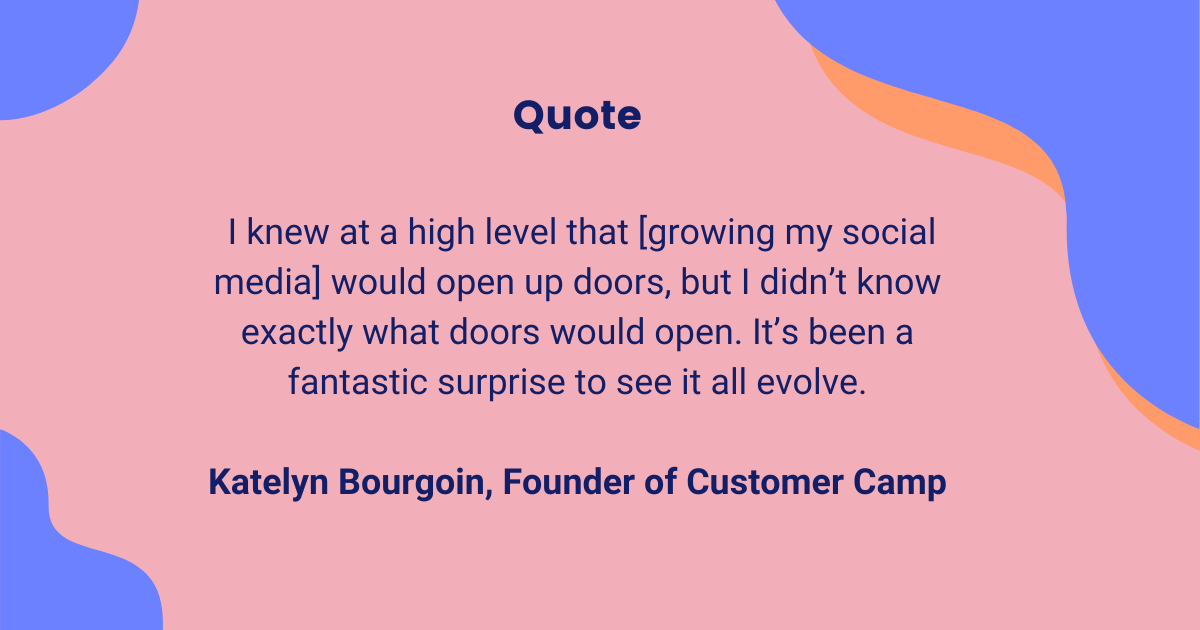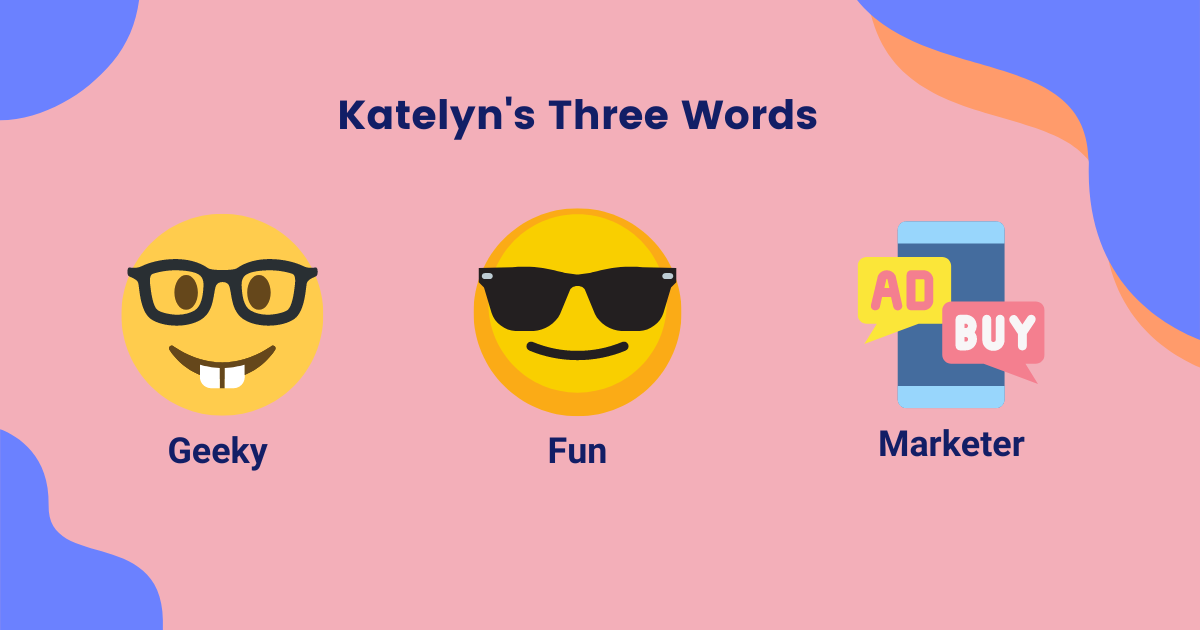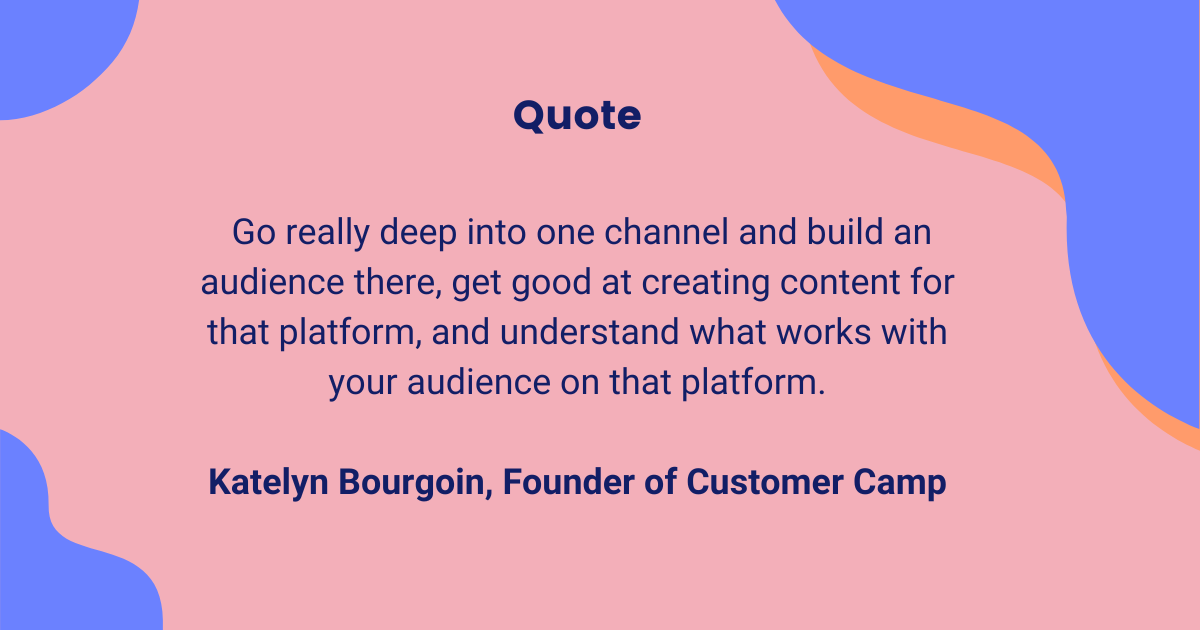Welcome to the sixth and final (for now) installment of Social Proof with Katelyn Bourgoin. Katelyn is an entrepreneur and creator who’s built several companies and agencies and even sold one successfully.
She’s currently working as the CEO and Lead Trainer at Customer Camp, a company dedicated to helping its clients better understand buyer psychology. Her wealth of experience in marketing and customer research has earned her the nickname of ‘Customer Whisperer’.
In this interview, we talk about how she grew her personal brand, with a newsletter called Why We Buy that has an audience of 10,000 people and a Twitter account with eight times that number.
Q: I’m so excited to have you on for Social Proof, Katelyn! What do you think about personal branding in general? And would you even call what you have a personal brand?
Yes, I would call it a personal brand. I wasn't very intentional about building a personal brand initially. What I knew was that I wanted to expand my audience beyond Atlantic Canada, which is where I'm based and where most of my clients are. But I didn't want to be beholden to only working with companies from one region, so it made sense for me to work on building an audience beyond.
I chose Twitter as my first platform because I like writing there – and I do some on LinkedIn now too. But I never went into it necessarily thinking, “I need a personal brand.”
I just started sharing things that I thought were interesting and interacting with people I admired and thought were interesting. I found that it was such a fun place to both create content and meet people that I just started spending more time there. The audience was growing and then eventually was like, “Oh snap, I think I have a personal brand.”
Q: There's often so much fighting for our attention, which must be even more prominent for you running a company, publishing on LinkedIn and Twitter, and writing a newsletter. How do you balance all of those things? Do you adopt a consistent voice across all your channels and cross-post content with a focus on one over another, or do you have a strategic approach for each channel?
It's a mix that started with boosting traffic for our business. For example, initially, I wasn't working with sponsors or doing any revenue-generation with my newsletter. I wanted to grow the email list, but I was using it as a channel to get the audience to discover the other parts of our business. I was also working on growing my social media following to grow awareness of the company more broadly. But I would say that since deciding to focus on growing the newsletter, I've become much more intentional about my social channels than before.
Where before I stuck to the same topic of customer research because that’s our main product, now I'm finding that I want to create something more like a hub and spoke model that more broadly covers buyer psychology. So I’m educating the newsletter’s audience on buyer psychology and then on why they need to do customer research on their own customer base.
Q: You already mentioned that it was the need to find customers outside your immediate region that led to you focusing on growing a personal brand. So chicken or egg question: would you say that it was a need to grow your business that led you to social media, or did social media inspire your business ideas?
There are opportunities that I have now because of growing my social that I never considered a possibility. I knew that building my social would allow me to open doors that may not have been open to me before.

But like with the newsletter, for instance, I never thought about growing my social so that I could one day have a newsletter that could become a revenue-generating asset for my business, but because I have the social channels and following. I knew at a high level that it would open up doors, but I didn’t know exactly what doors would open. It’s been a fantastic surprise to see it all evolve.
Q: Which of the channels you work with have been the most valuable for growing your personal brand?
I would say they each play a role. Twitter's definitely the place where I have invested the most time and energy. And because of that, most of my newsletter growth comes from there in the sense that it's someone finding the newsletter through Twitter and then recommending it there as well.
Then the newsletter allows me to deepen the connection with those people from Twitter because I get to have this amazing spot in their inbox every week where I get their full attention, as opposed to being in the feed where there are lots of other things competing for attention.
I’m fortunate to have both, and I'd much rather interact with my audience on Twitter than respond back and forth via email – I think it's more fun for us. The conversations are more effortless and casual. I think that the two are used in different ways but are also symbiotic. They work together.
Q: There is a question I like to ask which is can you define your personal brand in three words/phrases/terms?
I've given some thought to this because I used to own a branding agency. So we're very intentional about my brand, the Why We Buy brand. I want people to think about me in three words: ‘geeky’, ‘fun’, ‘marketer’.

I get excited about the nerdy parts of marketing – buyer psychology and understanding people, but I also want to make it fun. I want to make it fun for me, and I want to make it fun for my audience. So I'd say if I had to sum it up, I'm a geeky marketer, but I really want it to be fun. I want the people learning about the sometimes dry and dull stuff that we teach to be entertained.
Q: You have the label “Customer Whisperer” in your Twitter bio, which is so interesting. Is that an intentional personal brand label or a nickname that came about because of your work?
Well, somebody called me that, so I didn't come up with it myself. We offer training [at Customer Camp], and typically we would do it through partners here in Atlantic Canada. And one of our partners works for an organization that supports a whole bunch of different styles of businesses and helps them to export outside of Canada. And she started introducing me to the workshop participants as the Customer Whisperer.
So I started using it, and I think it creates curiosity which is really important in marketing, but it also speaks to an evident desire that people have which is they want to have more customers, and they know that they need to understand them to be able to have more of them. I think that it just fits with everything that I want to be about.
Q: That’s a cool example of the power of social proof in your personal brand – everything you’ve been communicating leads people to the conclusion you want them to have of you and your brand. You've done a lot of work with branding and understanding the customer psyche. Has that impacted how you communicate yourself and the projects that you work on or your achievements?
Absolutely. I don't consider myself to be a super customer researcher or buyer psychology expert, but I consider myself to be more like someone geeky about it and always learning. Oftentimes the topics that we're talking about in the newsletter are presented like I have a high-level understanding. But really, we’re just learning about it ahead of teaching it to others. There’s a lot that I'm learning about only weeks before I'm sharing examples in my newsletter or on social.
I love learning about these topics and then testing them in our own business and seeing what works for us and what doesn't. It always makes me reflect back on our own marketing collateral or website or on messaging and see opportunities for optimization. We experiment and apply many of the principles we cover because our audience relies on our advice, and we want it to work for our customers.
Q: Can you paint a picture of actions you’ve taken for your personal brand as Katelyn Bourgoin and not necessarily as Katelyn of Customer Camp? And what opportunities have these actions gotten you?
I would say the most significant actions that have led to opportunities are engaging with people I admire.
When we were still producing our podcast, most of our guests came through the interactions and relationships I’d built on social. I’d been engaging with people whose careers I admired, like Rand Fishkin and Bob Moesta, not for any ulterior motives but because I admired them. So when I reached out to get them on the podcast, they said yes. Then when we got to meet on the podcast, because we had so many things that we were geeky about in common, we would just start talking, and that led to other opportunities to get to work together. Bob Moesta and I co-hosted an event together, and Rand Fishkin invited me to a founder retreat he was doing in Italy. All of this came from getting to first start with very small interactions on social and amplifying their work, supporting them, and getting excited about what they were doing, which then led to real offline friendships with people who I only ever dreamed that I would get to talk to.
The benefit for my personal brand was that the more I got to kind of be seen in association with these folks – authority figures in their industry – it acted as a form of social proof: Oh, Katelyn got Rand on her podcast, that's amazing, or oh, she's doing a webinar with Bob Moesta, she must know her stuff.
The reality is it just came from starting to build a network on social and then turning that into a quick conversation and being excited about the same things and then turning those into friendships.
Q: Would you say that Customer Camp relies on your personal brand a lot, or have you been able to separate the two? I ask this because in my research before this interview, I almost fell into the trap of constantly equating everything Katelyn with everything Customer Camp.
If you asked me this question two years ago, I would have said very wholeheartedly, “I'm a champion of Customer Camp, but at the end of the day, I want people to know it's bigger than me.” I had a larger team at the time. And so yes, people will associate me with the brand as the founder, but ultimately Customer Camp is what I want people to think of, and I want there to be a separation between us.
In the last two years, my life has changed in many unexpected ways, some good and some difficult. So we had a baby, but at the same time, my husband ended up having two unexpected surgeries and was unable to work and lift our son. That caused me to make some changes to the business, and I had some plans of how I was going to grow Customer Camp that I reevaluated and changed.
Now I'm actually in the process of focusing on growing Why We Buy as a media brand and me being the face of that. So I'm okay with people associating Why We Buy, our newsletter, with me because I plan to grow that asset, and I want to be the face of it in the same way that – and this is a crazy example I'm not comparing myself to him – Joe Rogan is the Joe Rogan Experience. You can't just pop him out and put somebody else in and have the company be the same. I want to do that with Why We Buy, but that wasn't always the plan.
Q: With everything we've discussed so far in mind, what would you do if you were starting your personal brand today? What platforms or mediums would you decide to go with?
I'd probably still do Twitter because it fits into my life and takes advantage of my personal strengths with short-form writing.
I might also consider TikTok, but I could see myself getting into the weeds and trying to make the most elaborate TikToks ever. But I've intentionally stayed away from it because I just don't need another thing to be addicted to.
And I would throw LinkedIn in there as well. The nice thing is that you can repurpose most of your Twitter content. While I haven't been as intentional with LinkedIn as I'm going to start being, I have been able to take years worth of content that I've been creating over on Twitter and modify it for LinkedIn.
Q: Have you experienced any downsides in building a personal brand?
I wrote a thread about this when I crossed 75,000 followers on Twitter, sharing seven lessons I've learned and five hard things that nobody tells you about but growing your audience.
7 lessons I’ve learned on my way to 75,000 Twitter followers...
— Katelyn Bourgoin ⚡️ (@KateBour) August 5, 2022
(Plus 5 cautionary tales that no one tells you)
For one, social media becomes addictive and not in a good way. You're constantly logging in and refreshing, waiting for more notifications – that's not good for your brain. It's not good for your relationships because like you're way too plugged into what's happening on your phone.
Also, as your audience grows, it becomes more challenging to respond to everything and interact with everyone. Sometimes, I get hundreds of notifications – thousands if a post goes viral. I used to be able to interact with everyone, answer every question, and respond to every comment. Now I'm missing things, and it's hard to ensure I've interacted with everybody.
You'll also start to have a lot more people reach out to you, asking questions, for advice, for your time, and often people who you've never interacted with before. I'd like to get to a place where I can respond to everyone, but I don't see how unless I hire somebody to start managing my personal account. I don't see how I could keep up with it all, especially as the audience keeps growing.
And the final thing I talked about in the post is you start to compare yourself to other people. You compare yourself to other creators. You see people that are growing faster than you that are putting out a lot more content than you, and you wonder how they can do it all because they have a busy life too.
Q: What would you recommend for someone that is trying to be intentional about not only building their own channels, whether that's publishing YouTube videos or writing a newsletter, but also trying to deepen the connection with their audience on social media?
I think you should go really deep into one channel and build an audience there, get good at creating content for that platform, and understand what works with your audience on that platform. Once you have an audience – and it doesn't need to be a big audience – it might be time to get started getting people to sign up for a newsletter. Focus on publishing that newsletter every two weeks and getting your Twitter following to allow you in their inbox.

What I think that people struggle with is they try to be on too many platforms at once with a too-small team. If you have a larger team, it makes sense for you to be across these different channels. But for many companies, they've got one marketer, and they're expecting them to post to Facebook and Instagram and Twitter and Tiktok.
Show up in their attention, and then get their trust enough that they'll come to where you are and actually get value over in your place.
Q: Finally, I’d love to pull on the thread of going all in and direct that to the topic of picking a niche. Would you say that focusing on customer research and buyer psychology was a valid initial approach for your content?
It depends on what you're talking about and who your audience is. For Twitter, I was really focused on understanding the customer – that was the thing I wanted people to associate with me. But I also identified my sub-topics in offering marketing tips and generally sharing things from my personal life. I’m very intentional about staying on topic, but I pepper in other things to see the response.
With the newsletter, I tried to avoid a mistake I often see others make. They will pick a topic that aligns with the service that they offer or the products that they sell, but their audiences aren’t interested in reading about it every day. Or one that is only relevant to them when they're doing a relevant project. I've seen people launch newsletters on writing sales pages, and it's like, that's a newsletter that people are gonna sign up for when they have to write a sales page. And then, three weeks later, they're not going to open your emails anymore because it's not relevant.
So in my case, I could have written my whole newsletter about customer research, but in most companies, customer research is a project and not something they do every day. It's not something that they always care about. But buyer psychology is something that, regardless of what you're working on, it's going to be relevant whether you're designing a new landing page or whether you're trying to convince your boss to give you a raise.
When it comes to people's newsletters or YouTube shows, you want to grow an audience that's going to come back to you week after week. You want to make sure that the topic that you talk about is something that is going to be consistently relevant to them.
Takeaways
Katelyn’s experience building a personal brand has evolved with her growth as an entrepreneur. She’s become so well-known for her knowledge in buyer psychology and customer research that she earned the nickname “Customer Whisperer.” Here are some of the top takeaways from our interview with Katelyn about building a personal brand that speaks for itself:
- Pick a niche that has lasting relevance: Katelyn’s – and Customer Camp’s – expertise and service is in customer research. But both the founder and the company are known for a deep understanding of customer psychology – a broader topic that has relevance regardless of whether the audience needs their service or not. Try to find topics that your audience will always come back to you for, regardless of whether they need your services immediately or not.
- Start with one channel and work your way up from there: As Katelyn said, people often try to be on too many platforms at once but end up being spread too thin. Grow an audience and develop trust on one platform – then carry them over to other channels as you evolve your personal brand.
- Adopt cross-posting for your personal brand: A sentiment we also heard from Jack Appleby is that you should be repurposing content across your social media platforms. It saves you time and is an easy way to connect with a new audience using content you’ve already created.
🔌 Do you want to build deep relationships with your audience and show off your expertise? Start publishing consistently to your chosen channels with Buffer today.
Try Buffer for free
190,000+ creators, small businesses, and marketers use Buffer to grow their audiences every month.




